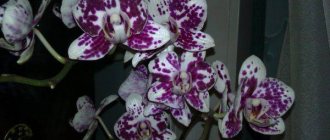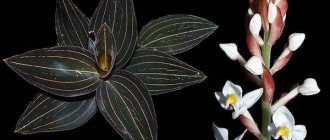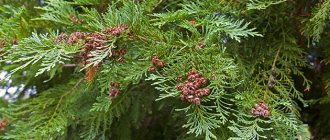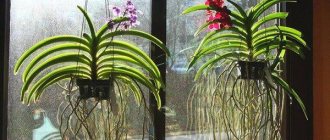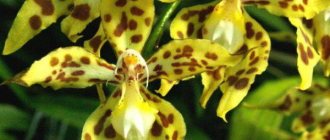Almost the most numerous genus of the Orchid family is the genus Bulbophyllum. The Internet project The Plant List says that there are almost 1,900 varieties of this plant, but foreign sources claim that there are many more species. The vegetation of this culture is very diverse, it can be difficult to understand that it is related.
Bulbophyllum orchids can be small or huge. Pseudobulbs, leaflets, their appearance and coloring differ in size. The Bulbophyllum orchid can bloom for several days or many months; there are varieties that bloom almost constantly, without interruption for a whole year, and do not require rest. Some plants are famous for their gorgeous inflorescences, while others are famous for their single flowers.
In most species of Bulbophyllum, the petals form a funnel-shaped depression, and there are plants that have long processes that look like the tails of mice and rats. Hence the name, which translates as “rat tail orchid.” Only a small amount of this vegetation has a pleasant floral aroma; most of the plants emit the smell of meat that has spoiled in order to attract flies for pollination.
In the natural environment, Bulbophyllum orchids have an epiphytic lifestyle; they rarely grow as lithophytes or spread the rhizome over the soil surface. Some varieties like to grow in temperate warm climatic conditions of rivers, where the air is always humid, but most grow in cool mountainous areas. Geography of distribution: tropics of America, Asia, islands of Oceania.
Appearance
This exotic plant is a plant with waxy flowers up to 10 cm long. The inflorescences are presented in a wide variety of colors - green, yellow, red, pink, white. In this case, various inclusions on the petals are acceptable.
The flowers are attached to peduncles 12 cm long. The shape of the inflorescences is usually racemose, and the inflorescences themselves consist of multiple or single flowers . The lip of the bud can be simple or divided into parts. Bulbophyllum leaves are oval, leathery, reaching 20 cm in length.
The shape and thickness of the leaves are varied. The leaves are attached to the top of the pseudobulb (the thickened near-earth part of the stem in which the orchid accumulates moisture). Each type of Bulbophyllum has a different smell - from pleasant to repulsive.
The Bulbophyllum orchid is native to the subtropical and tropical forests of Africa, Asia, the southern, central and northern regions of America and New Guinea. This type of orchid was first mentioned by the botanist Louis Marie Aubert Du Petit-Thouard in his book “The History of Special Orchid Plants Collected on the French Islands of Southern Africa: Bourbon and Madagascar.”
Botanical description and homeland of the plant
Bulbophyllum or Bulbophyllum is a large genus of the orchid family, including more than 200 species. They vary greatly in appearance, but they all form pseudobulbs, and flowering is always accompanied by a pleasant aroma (honey, almonds, cloves, fresh cucumbers, ripe melon, cut tropical fruits, dried grass) or stinking (decomposing meat, rotting fruit, boiled cabbage leaf, etc.) .P.).
Bulbophyllum Jellyfish at home photo
The size varies between 20-60 cm, of course the dimensions of the leaves and pseudobulbs vary, the flowers are single or collected in panicles. But the colors and shape of the corollas are surprising. In some, the petals hang in threads or ribbons, arranged in a fan; in others, the lip with the petals forms a shoe, a face, or is comparable to a tropical bird or insect.
Bulbophyllum emily siegerist photo
Monochromatic colors are almost never found; usually it is a combination of stripes, specks, spots and patterns of various shades. Thanks to their original beauty and relative ease of care, bulbophyllums become real stars of flower collections.
In nature, this genus of orchids is found in the tropics of Asia, Africa, America and the island of Madagascar.
When does bulbophyllum bloom?
The flowering period occurs at different times of the year and lasts from three days to several months. In most hybrids, flowering stems appear in summer, in others - in winter.
Subsorts with photos
It is impossible to mention all subvarieties of Bulbophyllum due to their large number; we will focus on the most basic ones.
Phalaenopsis
An orchid with leaves up to 120 cm long, with round pseudobulbs, with elongated flowers collected in a raceme . Many people note the unpleasant odor of this subvariety. Bulbophyllum phalaenopsis is native to Western New Guinea.
Echinolabium
Orchid with pink or red petals. The length of the peduncle is 70 centimeters, on which the buds are attached. The homeland of Bulbophyllum echinolabium is Indonesia.
Jellyfish
Exotic with dense dark green leaves . More than ten buds are attached to a long peduncle. Their flowering buds are similar to jellyfish, which gives the variety its name. The petals are white with orange or red splashes.
Lobba
This is a medium-sized orchid up to 30 cm long. On the peduncle there is only one flower with a diameter of 7 - 10 centimeters. At the same time, the length of the peduncle reaches 10 cm. The flower has a yellow-orange color with purple specks and stripes. The homeland of Bulbophyllum Lobba is Thailand, India and Burma.
Bulbophyllum: features of an orchid
Orchid Bulbophyllum: plant photo
The Bulbophyllum plant has a stem creeping along the surface of the soil, which bears single-leaf or bileaf convex or angular pseudobulbs. The top is covered with thin or hard and dense leaves, growing straight up or drooping.
The formation of Bulbophyllum peduncles occurs at the bases of the tuberidia, but in rare cases they are formed directly from the rhizome. Most wild varieties have many inflorescences, and only a few varieties are distinguished by one opening corolla on a flower stalk. Flowers can vary in size - there are species that have very small flowers, but there are also a large number of varieties with large flowers.
The Bulbophyllum flower is in the form of a voluminous lip, slightly pubescent or cilia. The flowers are simple or have 3 lobes. At the base you can notice a vertical and shortened column.
Bloom
The flowering time of Bulbophyllum depends on its species . Mostly orchids of this type bloom in summer, but some varieties can delight you with their flowering in late autumn or winter. Flowering also depends on the variety - sometimes it is small, and sometimes the orchid has only one bud.
Care before and after
Before flowering - as a rule, this is spring and early summer - Bulbophyllum needs to be fed with complex mineral fertilizers for orchids. The frequency of feeding is once every 2 weeks. After flowering, the peduncle is removed, and if necessary, the exotic plant is replanted. When replanting, special attention should be paid to the roots, preventing them from being damaged or rotting. After transplantation, it is not recommended to water the exotic plant for some time.
Important! After flowering, the exotic plant begins a period of rest, and it needs to be moved to a cool place at a temperature of 12-15 ° C.
What to do if it doesn't bloom?
If an orchid does not bloom, it means that the conditions under which it is kept do not meet the required conditions and the life cycle of the plant is disrupted. Pay attention to the watering regime, substrate moisture and the condition of the plant roots. The temperature regime is also important; the plant probably does not bloom due to overheating. Perhaps the orchid does not have enough strength to bloom and needs feeding.
Recommendations
- ^ a b c
"
Bulbophyllum medusae
".
World Checklist of Selected Plant Families (WCSP)
. Royal Botanic Gardens, Kew. - ^ a b
"
Bulbophyllum medusae
". Singapore State National Parks Board. Retrieved December 14, 2022. - " Cirrhopetalum medusae
".
World Checklist of Selected Plant Families (WCSP)
. Royal Botanic Gardens, Kew. - Lindley, John (1842). " Cirrhopetalum medusae
".
Edwards Botanical Register
.
28:12
. Retrieved December 14, 2022.
Growing
Choosing a location . It is best to place it on a windowsill facing south. Exotic must be protected from drafts and hypothermia. This variety is preferable to grow in hanging baskets and elongated pots. Miniature varieties of Bulbophyllum can be kept in special wet terrariums.- Preparing the soil and pot . Bulbophyllum can be grown with or without substrate. A wooden or clay pot is suitable for growing. The substrate must be breathable. A mixture of conifer bark with charcoal and sphagnum moss is ideal. When growing Bulbophyllum without a substrate (on blocks), it is recommended to make a small layer of moss between the plant and the block. This will prevent the roots from drying out.
- Temperature . Bulbophyllum loves high air temperatures (15°C and above in winter, and 25-30°C in summer).
- Humidity . The ideal humidity for this variety is 50% or higher, since dry air has a detrimental effect on the roots of the plant. To increase the humidity level, you need to place a tray with water. You can also use a household humidifier.
- Lighting . Bulbophyllum, as a light-loving plant, needs bright lighting, but in summer it needs slight shading from direct sunlight (for example, with a curtain) and fresh air.
- Watering . It is recommended to water the orchid abundantly in the summer; in winter, the frequency should be reduced. For irrigation, it is preferable to use warm distilled or purified water. Before watering, you need to make sure that the substrate is dry, but it should not be completely dry.
- Feeding . Exotic plants need to be fed once every two weeks with special mineral fertilizers dissolved in plenty of water. It is important to ensure that the orchid does not have an excess of nitrogen.
- Transfer. Transplantation should be done as needed, ideally once every 5-6 years.
- It is necessary to remove the orchid from the pot and inspect the soil to see if it is suitable for reuse. If necessary, a new pot should be taken larger if the orchid has grown.
- The root system must be thoroughly cleaned, removing all damaged parts.
- Place a layer of drainage at the bottom of the pot and fill the pot with substrate.
- The substrate can be bought ready-made or made yourself from a mixture of pine bark, sphagnum moss, rotted leaves and river sand (ratio 1:1:1:1). The bulbophyllum rhizome is fixed in the pot with a special device for fixing it.
Orchid transplant
It is necessary to replant the Bulbophyllum orchid when the rhizome begins to crawl beyond the edges of the container. It is recommended to replant in the spring, but the fact that the orchid blooms without interruption can make its contribution.
Algorithm for replanting Bulbophyllum:
- First you need to determine whether a transplant is needed. If the rhizome with pseudobulbs is located beyond the edges of the pot, then it’s time.
- The orchid is pulled out of the container; you need to carefully examine the roots. The soil mixture is replaced with a fresh one, but often it is used a second time if it does not begin to rot.
- A drainage layer is placed at the bottom of the container, followed by large parts of the soil mixture.
- The orchid is placed on top closer to the wall of the container, the root system is sprinkled with small fractions of the remains of the substrate.
- The flower is fixed with a specialized device to avoid its tilting during rooting in the new soil mixture.
- The transplanted plant is not watered immediately, only after a few days. It is worth feeding after 30 days.
Reproduction
As a rule, exotic plants are propagated by dividing the bush..
- To do this, the plant is removed from the pot, the rhizome is cleared of the substrate and divided into several parts, and each part should contain two or more pseudobulbs.
- The cut is processed with charcoal.
- Then each part is planted separately.
Reference! An orchid is considered rooted after the appearance of young shoots. More rare methods of propagation of Bulbophyllum are bulbs and seeds.
We invite you to watch a video about propagating an orchid by dividing a bush:
Bulbophyllum: orchid care
Bulbophyllum: video about growing an orchid
When watering Bulbophyllum orchids, it is important that the soil mixture is completely wetted, but excess moisture should not be in the pan. The soil mixture must not be allowed to dry out completely until it becomes crunchy. But in the winter season, under low temperature conditions, the number of waterings must be adjusted. The adjustment depends on the air temperature; in this case, drying the substrate for a short period is allowed.
Orchids grown in baskets or on a block are watered using the dipping method. The root system will tell you about timely watering. The roots are also sprayed with soft, warm water.
The crown of Bulbophyllum does not require very high humidity; the level that is present in the room is sufficient for it, which is approximately 35%, no less. Lower humidity can kill the orchid.
Feed Bulbophyllum once every 7 days on the leaves. A weak concentrate of specialized fertilizer mixtures for orchids is used, the dosage is reduced several times compared to the dose indicated on the pack by the manufacturer. Fertilizing is applied after watering, namely, in the afternoon, so that the effect of sunlight is no longer dangerous. In winter, the orchid is fed in rare cases; compared to the active growing season, fertilizer is applied once every 15-20 days.
Bulbophyllum is propagated by dividing the rhizome during replanting; 3 adult pseudobulbs should be left in each plot. The cut areas are powdered with powdered charcoal. Seed propagation is used by breeders to obtain new orchids of this genus.
Diseases and pests
- Sometimes spotting may appear on the leaves of the orchid. This indicates that the plant lacks shade.
- Also, with excessive lighting, the color of the leaves may change.
- Rotting pseudobulbs indicate that the plant is being flooded or the soil moisture is too high.
- Pest control such as spider mites and aphids is also important. The mite can be found on the back of the leaf with white dots and almost transparent cobwebs. Aphids attack the stems of exotic plants. To destroy pests, they are washed off and the plant is treated with a soap solution. It is prepared as follows: dilute 30 grams of laundry soap in a liter of water, add 2-3 ml of the Actellik preparation to the solution.
Bulbophyllums are known for their diversity, and among them you will definitely find one that you like. And following our recommendations will keep the plant healthy and enjoy its flowering .
More than 150,000 varieties and hybrids of orchids are known to science. You can learn about the best of them - Cymbidium, Miltonia, Cambria, Beauty, Manhattan, Multiflora, Paphiopedilum, Ludisia, Zygopetalum and Philadelphia - from our articles.
Diseases and harmful insects
Bulbophyllum has a more resistant immunity to disease than other varieties of orchids. The main difficulty that can affect the plant is the appearance of rot due to overwatering. Fighting rot and saving the orchid is possible if the crop is only slightly affected, as well as if the disease is detected in a timely manner. Fungicides are used, the soil mixture is dried or replaced with a new one, and the number and abundance of watering is subsequently adjusted.
Species with thin leaves are susceptible to frequent attacks by harmful insects. Aphids may appear on the orchid, but snails that enter the room with new flowers significantly damage the leaves. Pests are destroyed by insecticides; snails are eliminated by changing the soil mixture to a new one.
Mistakes that are made when cultivating bulbophyllums.
Strange spots cover the leaves, the color of the foliage changes to a lighter shade, this means that there is an excess of illumination in the room, you need to make a little shading, ensure light diffusion.
The ends of the leaves look as if they are burnt, this means that the plant has been overfed with nitrogen-containing mixtures; it is necessary to rinse the soil mixture well.
Rotting of pseudobulbs occurs after excessive watering, with high air humidity, with poor air circulation or in the absence of ventilation.
Flowering of Bulbophyllum is not observed, therefore, Bulbophyllum is very hot, or there is no regulation of watering, and watering can be either excessive or insufficient. An orchid may not bloom at any particular time, this may be due to the characteristics of some species.
Photo:
Bulbophyllum graveolens
GENERAL INFORMATION:
Bulbophyllum graveolens is native to the island of New Guinea, where the orchid grows epiphytically in humid forests at an altitude of 100 to 800 meters above sea level. Sympodial orchid, quite large in group, consisting of pseudobulbs growing quite closely to each other. Pseudobulbs are unifoliate, elongated ovoid in shape, with edges that become clearer with age, covered with dry skins underneath, measuring about 4-10 cm long and 3-4.5 cm wide. The leaves grow on a fairly long stalk (6-8 cm), shiny, with noticeable veins, ranging in size from 16 to 30 cm (in exceptional cases up to 50-55 cm) long and about 7.5-10 cm wide. The peduncles are at first straight, and then hang down under the weight of the buds, appear at the base of the pseudobulbs, can reach up to 20 cm in length and bear 15-20 flowers, fanned out in different directions. The flowers are fragrant (the smell is unpleasant, but not strong), green-yellow with a red lip, have a bract (2 cm long and 0.6 cm wide), measuring about 8 cm in diameter. The upper sepal is oval in shape, pointed at the tip, 2.5-3.5 cm long and 1.5-2 cm wide, often seems to hang over the column, has darker veins (7 pieces) on the outer side. The lateral sepals are long, closer to the middle they turn to the other side and touch (fuse) with each other, measuring about 4.5-5.5 cm long and 1.2-1.8 cm wide. Petals are small, most often little visible due to the lower sepals, grow parallel to the column, measuring about 1-1.5 cm long and 0.7-0.8 cm wide. The lip is sickle-shaped, fused with the column, red in color, tongue-shaped, its lateral parts are rounded, its overall size is about 1.6 cm long and 0.5 cm wide. The column is about 0.8 cm long, and its stalk is about 1.6 cm long.
Synonyms for this type of orchid are Bulbophyllum pachybulbum, Cirrhopetalum graveolens, Cirrhopetalum pachybulbum and Cirrhopetalum robustum.
TEMPERATURE:
An orchid’s adherence to a particular temperature regime largely depends on the conditions under which the largest number of new cells of peduncles, leaves, roots and new shoots are formed. In order to understand what the IDEAL TEMPERATURE REGIME for Bulbophyllum graveolens, you need to turn to its natural habitat. A hot, humid climate reigns here, in some regions the amount of precipitation is uniform throughout the year, and in some places there is a relative dry period that lasts about 2 months, while it is dry for no more than 20-30 days, the rest of the time it is rather conditionally dry. Since Bulbophyllum graveolens, although it grows in humid forests, its position is quite specific - it is most likely the upper part of the forest, where it is hot and the general level of air humidity is lower than below (tourists receive more humidified air than the plant), the light is bright and even during days in some places straight. It was the direct hot sun that caused Bulbophyllum graveolens to adapt its photosynthesis to the CAM pathway. Against the background of all orchid species taken together, it is the Bulbophyllum group that shows the closest CAM-PHOTOSYNTHESIS , i.e. more similar to cacti, which is what makes this group so extensive and widely loved among orchid lovers, as it is best suited for an ordinary window sill.
On the inside of the leaves of Bulbophyllum graveolens there are holes through which the plant exchanges gases with the environment. This is a very important process, if only because CARBON - the primary element in the construction of new cells (roots, peduncles, leaves, etc.). It comes in the form of carbon dioxide. And it is precisely the process of entry, fixation and processing of this very carbon dioxide that is very important for understanding the temperature regime of Bulbophyllum graveolens. The above mentioned openings are called STOMA . THE DAY , due to the heat and relatively dry air, they are usually tightly CLOSED , there are relaxations in the morning and evening hours, when it is not so hot, but most of the daylight hours they are still closed. When the heat subsides, air humidity at night , the stomata OPEN and begin to “catch” carbon dioxide. Since during the day they are passive, then, in principle, the daytime temperature of Bulbophyllum graveolens is not of fundamental importance. In nature it is about 28-31 °C. In home culture, it can also be anything - warm, moderate or moderately warm, as long as it is not prohibitively hot, burning the plant, i.e. no higher than 35-37 °C.
NIGHT CONTENT TEMPERATURES are of more fundamental importance for CAM-PHOTOSYNTHESIS orchids , since carbon dioxide is collected precisely at night. So that the stomata can not only open at night, but also collect some useful amount of carbon dioxide, it:
- IN THE DAY there should be good (sufficient for active growth) SUN shining , and
- At NIGHT the environment is HUMID and COOL (maximum + 24 °C).
Any deviation from the first or second point will directly affect the amount of gas collected, and therefore the growth rate, flowering ability, etc.
It doesn’t matter how you keep your orchid during the day, the main thing is that at NIGHT the temperature be higher than + 24 °C , IDEALLY FROM + 18 °C to + 22 °C . If we assume that the daytime sun is always good, then a “bad” night temperature will result in either little or no carbon dioxide being collected. In turn, this is fraught with the fact that the orchid will begin to take it from the inside - from the old pseudobulbs, gradually killing them ahead of schedule, therefore, the plant will gradually become depleted, degenerate, etc. The more bad (useless) nights Bulbophyllum graveolens has in its life, the faster it will begin to eat itself and the worse it will grow, bloom, etc.
LIGHT:
Bulbophyllum graveolens is a fairly light-loving orchid. Even in natural climates it sits relatively high in trees, where it receives some direct sun. An orchid's need for sunlight can be expressed as "slightly above average", which is not as much as for Cattleya or Vanda, but also higher than for Phalaenopsis.
Looking at the windows in the apartment, we can say that the best place is the TOP OF THE WEST WINDOW . The peduncles of Bulbophyllum graveolens are drooping, sometimes they bend 5 cm below the pot, so in principle it is initially better to grow the plant in a suspended state, choosing a place where the sun shines the least. There is such a place on any window (any orientation). Regarding the western side, this is where the sun shines at the very beginning, since it moves quite quickly. It may happen that in the midst of summer the orchid will still have to be hung behind the curtain on a table or shelf near the window; this should be done if the color of the leaves begins to resemble yellowish.
Windows of other orientations should be tested first, since the content on them depends on many factors. If the orchid does not burn and blooms at least once every 12 months, then the light here is acceptable. If the growth is too long and periodically slows down, it means there is not enough light, but if the color of the plant itself (especially the leaves) has changed greatly, or it has begun to become smaller, then there is too much light and it is still better to change the location.
SUBSTRATE:
When choosing a method for growing Bulbophyllum graveolens, you must first understand that this orchid has a fairly thin and very delicate root system, for which long-term drying is contraindicated. The velamen layer is 1-2 cells even on roots hanging in the air, so it is best to plant the orchid in hanging pots in a moisture-intensive mixture with a predominance of sphagnum or in pure sphagnum moss. Keeping it on blocks in a greenhouse or orchidarium culture is possible, but relatively short-lived, since the orchid grows quickly and can simply break the block under its weight.
TRANSFER:
Bulbophyllum graveolens does not need frequent replanting, so it is advisable to replant the orchid only when it is really necessary. For example: If you water it with ordinary tap water, the pH of which is between 7.2 and 7.8, then over time, usually within 2 years, the favorable pH of the substrate (from 5.5 to 6.5) will also will jump to this indicator, and the orchid will no longer be able to absorb many useful substances, for example, iron, which means it will begin to lose the color of the leaves - turn yellow. In addition, salts accumulate in the substrates from fertilizers or when watering with poor quality water, which the orchid cannot quickly (or at all) absorb and process, reaching a certain amount, they can cause a massive root burn, and the orchid will lose all its roots overnight (shrink). The best time for replanting is the period when new young shoots begin to develop their own roots, which will allow the orchid to quickly gain a foothold in the new substrate.
AIR HUMIDITY:
The natural climate of the island of New Guinea, although it is characterized by high air humidity, is rather average where Bulbophyllum graveolens hangs on the trees, approximate figures: 60% during the day and 80-85% at night. The orchid carries out its photosynthesis via the CAM pathway, so it is initially well adapted to the conditions of our apartments.
Air humidity for Bulbophyllum graveolens plays an important role at NIGHTTIME , when its general level is already elevated, and if, in addition, the condition for temperature moderation is met, then the humidity indicator, in principle, without effort on your part, should be rather elevated, rather than at a low level. The higher it is, the easier it is for stomata to work - to collect and fix carbon dioxide. Ultimately, it will all come down to the amount of carbon that the orchid has collected.
In winter, when the batteries are working, air humidity also plays the role of regulating the amount of water evaporated from the stomata. The lower it is, the more it comes out, and this interferes with carbon collection, and vice versa.
To increase the air humidity directly around the plants (not to be confused with the room as a whole), you can use a humidifier or equip the window sill with trays with wet expanded clay (sand, peat, etc. materials). Under the influence of a heating factor - (direct) sunlight (unfortunately, the effect weakens by night) or a battery (in winter), the expanded clay heats up, the water evaporates, increasing the humidity of the air around the orchids. If there is no heating, it is recommended to place a heater at the bottom of the pan.
REMEMBER
that when caring for orchids in conditions of high air humidity, it is necessary to regularly ventilate the room where the plants are kept, since moist, stale air is an ideal environment for the mass reproduction of various types of fungal and bacterial diseases.
WATERING:
When organizing watering of Bulbophyllum graveolens, you need to take into account that if it also has roots, for example, growing in pure sphagnum, which have never dried out, then the watering regime should be similar. The roots of this plant tend to form root hairs in a very humid environment, through which water is absorbed; when they dry out too much, they die, which means that the next watering regime can no longer be as wet as before. Either you keep the plant always moist, or alternate between drying and watering. The first mistake that novice orchid lovers make is that the plant is first thoroughly dried and then kept in a swamp. One good drying will deprive the roots of the need for too wet content, then it will only work to the detriment.
An important factor in care is QUALITY
irrigation
WATER
, for example, it is considered ideal for a plant: water conductivity 100 to 200 µS (maximum 600 µS), acidity 5-6 pH, and hardness not higher than 12 °dH. In view of this, it is PREFERABLE to use soft, filtered water for irrigation (for example, through reverse osmosis) or a mixture of ordinary tap and distilled water in a 1:1 ratio. When using tap water, remember that its quality is better in a hot tap, since it contains fewer impurities to prevent scale on the pipes, and accordingly, its pH is not very high [read more about watering orchids...]. The worse the water used, the more harmful compounds will accumulate in the substrate and the higher the likelihood of mass burning of the roots - blackening and drying out (outwardly similar to fusarium)!
FEEDING:
During the period of active growth, this type of orchid is fertilized at every watering with 1/2 or 1/4 of the fertilizer concentration indicated on the package (depending on the quality of the water in which the fertilizer is diluted). The roots of Bulbophyllum graveolens are quite sensitive to various types of potassium, phosphorus, etc. salts contained in the fertilizer and can deteriorate very quickly. The most sensitive part of a growing root is its tip, and when exposed to too concentrated fertilizer, they turn black and dry out. In addition to regular root feeding, foliar feeding can also be done, when the outer part of the plant is sprayed with a very diluted fertilizer. It is best to feed the orchid by alternating both of these methods. It is advisable to use a specialized fertilizer, marked on the package “For orchids”, since conventional fertilizers for indoor plants are oriented for use in ordinary soil and when used in bark-based substrates, most of the salts settle as dead weight in the substrate itself, creating an unfavorable environment for the root plant. orchid systems environment, leading over time to their massive burning. The best fertilizer is considered to be one containing nitrogen, phosphorus and potassium in equal parts, for example, NPK = 3-3-3 or 8-8-8. If you do not have such a fertilizer, then alternate - once a fertilizer with a high nitrogen content, and another time with a high phosphorus content.
REST PERIOD:
The natural climate of the island of New Guinea partially provides for the presence of a PERIOD OF DROUGHT, but there is none directly in the places where Bulbophyllum graveolens is located. Precipitation here falls evenly throughout the year, thereby in no way even slowing down the growth of the orchid.
A slightly different picture is observed in our latitudes on our windowsills. Approximately from March to September, sunlight can be called SUFFICIENT for the active growth and development of an orchid; the rest of the time, the “good” sun rarely shines, most often 2 times a week for no more than 2 hours, some meager growth processes can be observed. In view of this, if the windows are not equipped with winter support in the form of FITOLAMPS [read more about lighting for orchids...], then it is likely that at this time Bulbophyllum graveolens will fall into a “comatose-sleeping state”, requiring somewhat different care than active growth. There are several nuances to consider here:
- A “sleeping” plant almost does not absorb moisture; when watering, water flows capillarily into the upper layer of the root - velamen (if there is one at all), but does not go further, therefore, if your orchid has fallen asleep due to insufficient lighting, then watering it means maintaining the roots tone so that they do not dry out ahead of time, and accordingly, there is no need to abuse them.
- If your “sleeping” orchid is located near a heat source - a radiator, then moisture is actively evaporated from the surface of its leaves, which in turn is not replenished through the roots. In such conditions, after some time, the leaves of the plant will weaken, wrinkle and droop. REMEMBER
that the lower the temperature, the less the plant “sweats”.
As soon as the light intensity increases in the spring, the orchid will wake up and continue its development further.
BLOOM:
The peak of flowering of Bulbophyllum graveolens occurs from the end of March to the beginning of September. The total duration of flowering for each individual flower is about a week, and the entire plant can bloom for months.
AFTER FLOWERING:
After flowering, the peduncle of Bulbophyllum graveolens is removed, if necessary, the orchid is replanted and kept relatively dry for some time. This is necessary to acclimatize the plant and to prevent rotting of wounds on the roots resulting from transplantation.
REPRODUCTION:
At home, this type of orchid reproduces, as a rule, only VEGETATIVELY
, i.e. by dividing a large adult bush into parts. To ensure that the new plot suffers as little pain as possible and starts to bloom faster, it is recommended to leave at least three pseudobulbs or two adults with new sprouts for each new plant. In greenhouse conditions, seed and meristem propagation is also used.
OUTDOOR RESIDENCE:
In the period from the beginning of May to mid-September, it is highly recommended to keep this type of orchid outdoors: on a balcony or in the garden, since this is where the natural differences between night and day temperatures that the plant needs so much take place. You need to choose a place protected from rain, strong winds and direct sunlight.
KNOWN HYBRIDS:
Based on Bulbophyllum graveolens, the following strategically important HYBRIDS were formed:
- Bulbophyllum Grouville = Bulbophyllum lobbii x Bulbophyllum graveolens
- Bulbophyllum Meen Bulan Mantra = Bulbophyllum mastersianum x Bulbophyllum graveolens
- Bulbophyllum Meen Dragon Claw = Bulbophyllum appendiculatum x Bulbophyllum graveolens
- Bulbophyllum Mot Mittraphap = Bulbophyllum levanae x Bulbophyllum graveolens
- Bulbophyllum Wilmar New Generation = Bulbophyllum graveolens x Bulbophyllum affine
All of the materials presented above are the property of this site, the full or partial publication of which (according to Article 1270 of the Civil Code of the Russian Federation) on other resources without the consent of the copyright holder is prohibited and is punishable by a fine of 10,000 to 5,000,000 rubles (Article 1252 of the Civil Code of the Russian Federation).
World of Orchids
